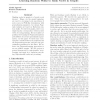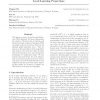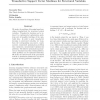88
Voted
ICML
2007
IEEE
16 years 1 months ago
2007
IEEE
Structural alignments are the most widely used tools for comparing proteins with low sequence similarity. The main contribution of this paper is to derive various kernels on prote...
ICML
2007
IEEE
16 years 1 months ago
2007
IEEE
We consider a setting for discriminative semisupervised learning where unlabeled data are used with a generative model to learn effective feature representations for discriminativ...
101
Voted
ICML
2007
IEEE
16 years 1 months ago
2007
IEEE
Ranking nodes in graphs is of much recent interest. Edges, via the graph Laplacian, are used to encourage local smoothness of node scores in SVM-like formulations with generalizat...
102
click to vote
ICML
2007
IEEE
16 years 1 months ago
2007
IEEE
This paper presents a Local Learning Projection (LLP) approach for linear dimensionality reduction. We first point out that the well known Principal Component Analysis (PCA) essen...
131
Voted
ICML
2007
IEEE
16 years 1 months ago
2007
IEEE
We consider the problem of multi-task reinforcement learning, where the agent needs to solve a sequence of Markov Decision Processes (MDPs) chosen randomly from a fixed but unknow...
102
Voted
ICML
2007
IEEE
16 years 1 months ago
2007
IEEE
The large number of genes and the relatively small number of samples are typical characteristics for microarray data. These characteristics pose challenges for both sample classif...
124
click to vote
ICML
2007
IEEE
16 years 1 months ago
2007
IEEE
The choice of the kernel function which determines the mapping between the input space and the feature space is of crucial importance to kernel methods. The past few years have se...
106
click to vote
ICML
2007
IEEE
16 years 1 months ago
2007
IEEE
We study the problem of learning kernel machines transductively for structured output variables. Transductive learning can be reduced to combinatorial optimization problems over a...
86
Voted
ICML
2007
IEEE
16 years 1 months ago
2007
IEEE
In this paper we consider the problem of classification in the presence of pairwise constraints, which consist of pairs of examples as well as a binary variable indicating whether...
104
click to vote
ICML
2007
IEEE
16 years 1 months ago
2007
IEEE
In many real-world applications, Euclidean distance in the original space is not good due to the curse of dimensionality. In this paper, we propose a new method, called Discrimina...



